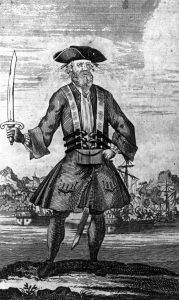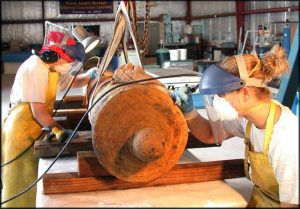Queen Anne’s Revenge
In the summer of 1718 two large wooden ships sank in the sandy shoals of Beaufort Inlet, formerly Topsail Inlet, about one mile off the coast. These two ships, known then as the Adventure and Queen Anne’s Revenge, were pirate ships commanded by the notorious Captain Thache, also known as Blackbeard. Having run the larger QAR ship aground on a hidden sand bar, the Adventure attempted a rescue and failed, and also met its demise in the watery depths of Beaufort Inlet. As the pirates scrambled to get off the sinking vessels and take what they could with them, Blackbeard and a small group of his most loyal men commandeered a small sloop (a sailing boat with a single mast), which they used to flee the scene. He would later be caught and killed in the battle at Ocracoke when he faced off with Lieutenant Robert Maynard of the Royal Navy. So the life of Blackbeard ended as his legend began.

Fast forward to 1996, when the lost shipwreck was finally found by a private salvage company searching for a different wreck. They contacted the Underwater Archaeology Branch at the North Carolina Department of Cultural Resources. Soon after, the North Carolina Governor announced to its citizens and the world that the famous pirate’s flagship had been found at last. That began what is known today as the Queen Anne’s Revenge (QAR) Shipwreck Project, a state-funded and owned archaeological recovery project now 20-years underway.
The Ship’s History
Let’s review the story of the ship and how it came to be in the possession of Blackbeard. Historical records tell us that the ship, christened La Concorde, was built sometime around 1710 near the French port of Nante. It was owned by a merchant named Rene Montaudoin, who initially used the ship for privateering during the War of Spanish Succession. In 1713, as the war ended, he converted the three-masted ship for moving enslaved Africans from their homelands to the Caribbean Islands and colonial America to work as laborers in the sugar plantations. Known as the Triangle of Trade, European merchants traveled to the coast of African to trade goods for slaves, then took the slaves to the New World in exchange for goods to return to Europe. This practice continued for nearly 300 years. The trip from Africa to the New World was called the Middle Passage, and under the harsh conditions of cruelty, weather, and exposure, many captives died along the way. On their arrival to the New World, they were sold in market places like chattel or saleable goods.

On its third voyage as a slave-trade ship in November 1717, Concorde was captured by Blackbeard and his crew near the island of Martinique in the Caribbean. The French captain and his crew put up little resistance because they were depleted in numbers from sickness and death. It was an easy catch for the pirate captain, who retained 10 members of the French crew, setting the remainder free, including most of the human cargo. For the next six months this vessel served as the flagship of Captain Thache as he continued to raid the shipping lanes of the Atlantic coastline. While trying to enter the inlet near Beaufort, North Carolina, the ship became stuck on a submerged sandbar, eventually sinking below water—out of sight and memory. Historical documents and eyewitness accounts tell us no lives were lost during the event, but what remained on the ocean floor awaited archaeological recovery.
Archaeological Investigations
Once the wreck was discovered, the Underwater Archaeology Branch (UAB, NCDNCR) staff developed a plan to scientifically explore, record, and recover what they could of the Queen Anne’s Revenge, which lay submerged below about 23 feet of water. Working in collaboration with East Carolina University, the UAB established a Conservation Laboratory on their west campus which would receive the artifacts brought up from the salt-water wreck and begin the long process of conservation—a process that must be done quickly before the artifacts deteriorate from exposure to air and other elements. When the weather was cooperative the divers would work as a team to map, photograph, and excavate portions of the shipwreck site. Using standard underwater archaeological techniques, a grid system was superimposed across the site’s debris field to record the locations of artifacts in situ (in their original places) before being removed for study and display. As with most archaeological endeavors, this recovery and documentation process has been a slow and tedious process as great care is taken to first record and then remove the artifacts from their original context. Some artifacts, like cannons and anchors, weight 1,000 of pounds or more, and can be challenging to bring up from the ocean floor.

During seasonal visits to the shipwreck site, divers have now recovered more than 300,000 artifacts from about 60 percent of the site. The site, which spans an area 200 ft. by 75 ft., is located near Fort Macon, a mile off the coast and 23 ft. below water surface. Very little of the wooden ship has survived the harsh salt-water environment, but a few structural elements like the sternpost, some planking, the toilet liner, some sailcloth, metal fasteners (iron nails and eye-bolts), and lead patches tell us what the ship may have looked like.
Artifacts related to weaponry have been found, including iron cannons (29 total), cannon balls, gun parts, ammunition (1000s of lead shot), sword parts, and hand-grenades. It reflected an arsenal, ready to fight. Personal gear of the French crew and later the pirates and their passengers included mostly metal items such as shoe buckles, buttons, straight pins, and scissors as well as ceramic tobacco pipes and lead gaming markers. Navigational instruments made of copper or brass have been found, such as compasses, dividers, sounding weights, and measuring implements. Medical equipment, used by the ship’s French doctors to treat the crew and cargo alike, also has been identified, including a mortar and pestle, pewter syringes, a cauterizing iron for sealing wounds, brass nested weights for measuring medicines and compounds, and a pewter bleeding bowl.

Artifacts related to the eating and drinking by the captain, crew, and passengers include large German stoneware jugs used to store liquids (rum, brandy, and water), small French earthenware dishes for dinning, English glass stemware for the captain’s table, pewter plates and dishes for serving food, pewter and silver utensils (mostly spoons), and French and English glass bottles that held wine and gin. A single fragment of a Chinese porcelain teapot lid has been identified, suggesting someone on board enjoyed the ritual of tea drinking. A few artifacts are directly related to the ship’s use as a slave trade vessel, including iron shackles used as restraints, tiny fragments African gold jewelry and gold dust, lots of glass trade beads, and a few copper beads.
Conservation Continues
As archaeological recovery continues periodically, conservation work in the QAR laboratory continues on a daily basis as large concretions are broken down using mechanical drills and chisels. Concretions are formed on the oceans’ floor as the objects, especially ones made of iron, are encased in botanical and chemical coatings of decomposing minerals and sea life (like barnacles). These concretions seal the host artifact (and sometimes multiple artifacts) into large clumps, which need to be broken apart with great care under controlled conditions in the laboratory. Conservators x-ray most of these large clumps to see what is “inside” each concretion and how best to begin the break down. Then each object must be conserved based on its material type (iron, pewter, horn, cloth, glass, ceramic, etc.), with the salt-water removed very slowly to preserve the artifact. The QAR shipwreck project has its own conservation team who perform these tasks, in tandem with many specialists who, over the past 20 years, have assisted in the identification and dating of the 18th century artifacts found at this site. The QAR Conservation Lab welcomes the public during their annual Open House events and provides group tours upon request.

Once the artifacts are removed from concretion, stabilized, and studied, they are transferred to the North Carolina Maritime Museum in Beaufort and subsequently displayed there or at other venues such as the Smithsonian Institution’s Museum of American History in Washington, DC, the NC Museum of History in Raleigh, and the Museum of the Albemarle in Elizabeth City. In 2018 the shipwreck will be 300 years old and the public is invited to join in the celebration of what is one of North Carolina’s most unique archaeological sites.
Contributor
Linda F. Carnes-McNaughton (Cultural Resources Management Program, Fort Bragg)
*Images courtesy of the North Carolina Department of Natural and Cultural Resources, Raleigh.
**Blackbeard illustration from A General History of the Robberies and Murders of the Most Notorious Pyrates by Captain Charles Johnson (1724), London.
Sources
Wilde-Ramsing, Mark U., and Linda F. Carnes-McNaughton
2016 • Blackbeard’s Queen Anne’s Revenge and its French Connections. In Pieces of Eight: More Archaeology of Piracy, edited by Charles Ewen and Russell Skowronek. University of Florida Press, Gainesville.
Wilde-Ramsing, Mark U., and Charles R. Ewen
2012 • Beyond Reasonable Doubt: A Case for Queen Anne’s Revenge. Historical Archaeology 46(2):110-33.
Wilde-Ramsing, Mark U., and Linda F. Carnes-McNaughton
2018 • Blackbeard’s Sunken Prize: The 300-Year Voyage of Queen Anne’s Revenge. University of North Carolina Press, Chapel Hill.
